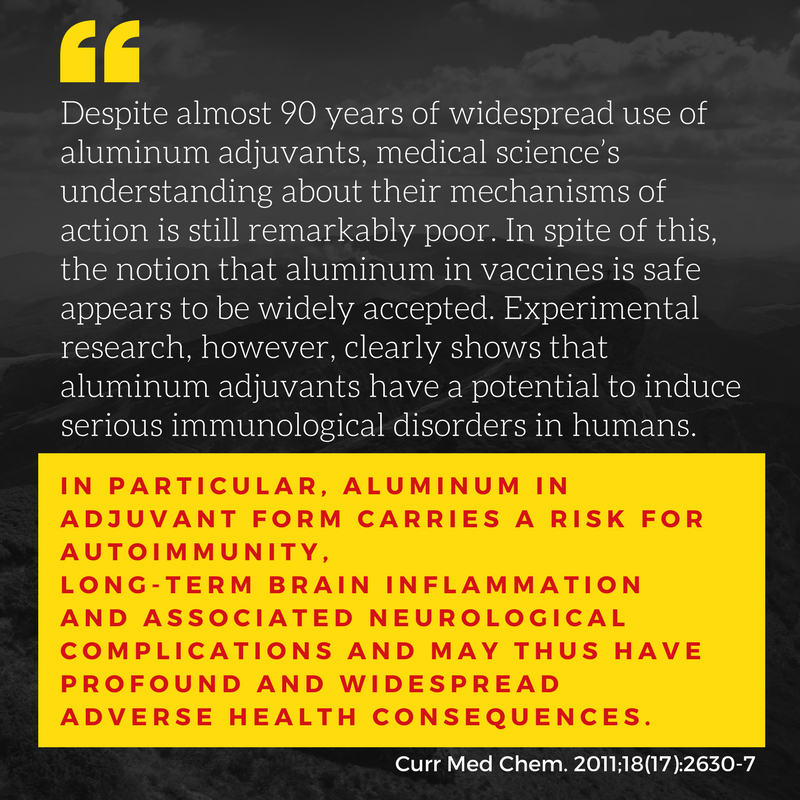Flawed Science: Newborn Receives Same Dose of Neurotoxic Aluminum in Vaccines as 160 Pound Adult

Regarding the aluminum in vaccines is the amount of aluminum allowed in a vaccine administered to a newborn based on safety studies? Is the dose based on the infant’s weight? On the amount of aluminum a newborn’s kidneys can safely eliminate? On the fragile state of the child’s developing immune and neurological systems? On the current science of aluminum particle neurotoxicity?
No.
March 2018 published paper reveals how the FDA determined the allowable amount of aluminum in a single vaccine–the same amount for a 7lb newborn as a 160lb adult–and reveals that it is absolutely critical for everyone who administers vaccines to children to cease following the CDC’s pediatric schedule and begin considering what is best for their young patients.
The Highlights of this paper include:
- Aluminum levels in vaccine is based on immune efficacy and ignore body weight for safety
- Several critical mistakes have been made in the consideration of pediatric dosing of aluminum in vaccines
- Safety inferences of vaccine doses of aluminum have relied solely on dietary exposure studies of adult mice and rats
- On Day 1 of life, infants receive 17 time smore aluminum than would be allowed if the doses were adjusted per body weight
- Revised MRL calculation based on weight sare provided, but are also based on derived speculation, NOT on safety data
March 2018 Journal of Trace Elements in Medicine and Biology Volume 46, March 2018, Pages 76-82

What is an adjuvant?
From the CDC: “An adjuvant is an ingredient of a vaccine that helps create a stronger immune response in the patient’s body. In other words, adjuvants help vaccines work better. Some vaccines made from weakened or dead germs contain naturally occurring adjuvants and help the body produce a strong protective immune response. However, most vaccines developed today include just small components of germs, such as their proteins, rather than the entire virus or bacteria. These vaccines often must be made with adjuvants to ensure the body produces an immune response strong enough to protect the patient from the germ he or she is being vaccinated against.”
From VaccinePapers.org:
“The Dwoskins had attended the Institute of Medicine (IOM) and FDA meetings on vaccines, where aluminum was briefly discussed. Both the IOM and FDA acknowledged that aluminum adjuvant toxicity had not been studied. Inferences had been made, based on single-vaccine studies, but experiments to measure the toxicity of aluminum adjuvant had never been done (except by Shaw). In particular, nobody had ever tested the effect of the total amount of aluminum adjuvant received from the vaccine schedule recommended by the CDC.”
For the results of aluminum-adjuvant injection experiments that replicated the CDC pediatric schedule, visit VaccinePapers.org. Key findings: Administration of aluminium to neonatal mice in vaccine-relevant amounts is associated with adverse long term neurological outcomes.
An article about Aluminum Toxicity and History from Health Freedom Idaho’s toxicologist
Dr. Suzanne Humphries breaks down the issue of aluminum into fine detail to help you better understand its use and effects.
This video explains forms of aluminum adjuvants and inaccurate labeling.
Here she explains the different forms of aluminum adjuvants and how mislabeling has played a role in obfuscating the common ingredient of several vaccines that continues to cause injuries.
Aluminum Adjuvants
Abstract: Aluminum vaccine adjuvants: are they safe? Curr Med Chem. 2011;18(17):2630-7.
“Aluminum is an experimentally demonstrated neurotoxin and the most commonly used vaccine adjuvant. Despite almost 90 years of widespread use of aluminum adjuvants, medical science’s understanding about their mechanisms of action is still remarkably poor. There is also a concerning scarcity of data on toxicology and pharmacokinetics of these compounds. In spite of this, the notion that aluminum in vaccines is safe appears to be widely accepted. Experimental research, however, clearly shows that aluminum adjuvants have a potential to induce serious immunological disorders in humans. In particular, aluminum in adjuvant form carries a risk for autoimmunity, long-term brain inflammation and associated neurological complications and may thus have profound and widespread adverse health consequences. In our opinion, the possibility that vaccine benefits may have been overrated and the risk of potential adverse effects underestimated, has not been rigorously evaluated in the medical and scientific community.”
Aluminum Toxicity Studies
2002 “Neurological adverse events associated with vaccination.”
2002 “The potential role of aluminium in Alzheimer’s disease.”
2004 “Neurotoxic effects of aluminium among foundry workers and Alzheimer’s disease.)
2007 “Aluminum adjuvant linked to Gulf War illness induces motor neuron death in mice.”
2007 “Mechanisms of aluminum-induced neurodegeneration in animals: Implications for Alzheimer’s disease.”
2007 “Inflammation, neurodegenerative diseases, and environmental exposures.”
2009 “Aluminum hydroxide injections lead to motor deficits and motor neuron degeneration.”
2011 “Aluminum toxicity and astrocyte dysfunction: a metabolic link to neurological disorders.”
2011 “Aluminum vaccine adjuvants: are they safe?”
2011 “Metal ions affecting the neurological system.”
2013 “Autoimmune/autoinflammatory syndrome induced by adjuvants (ASIA syndrome) in commercial sheep.”
2014 “Aluminum-induced entropy in biological systems: implications for neurological disease.”
2014 “Are there negative CNS impacts of aluminum adjuvants used in vaccines and immunotherapy?”
“Being involved in the production of reactive oxygen species, aluminium may impair mitochondrial bioenergetics and may lead to the generation of oxidative stress. In this review, we have discussed the oxidative stress and mitochondrial dysfunctions occurring in Al neurotoxicity. In addition, the ameliorative measures undertaken in aluminium induced oxidative stress and mitochondrial dysfunctions have also been highlighted. ”
2015 “Trace elements in scalp hair samples from patients with relapsing-remitting multiple sclerosis.”
2015: “Biopersistence and brain translocation of aluminum adjuvants of vaccines”
“We previously showed that poorly biodegradable aluminum-coated particles injected into muscle are promptly phagocytosed in muscle and the draining lymph nodes, and can disseminate within phagocytic cells throughout the body and slowly accumulate in brain. This strongly suggests that long-term adjuvant biopersistence within phagocytic cells is a prerequisite for slow brain translocation and delayed neurotoxicity.”
“We demonstrate that not all aluminium adjuvants are equal neither in terms of their physical properties nor their biological reactivity and potential toxicities both at the injection site and beyond. High loading of aluminium oxyhydroxide in the cytoplasm of THP-1 cells without immediate cytotoxicity might predispose this form of aluminium adjuvant to its subsequent transport throughout the body including access to the brain.”
“Vaccine adjuvants and vaccines may induce autoimmune and inflammatory manifestations in susceptible individuals. To date most human vaccine trials utilize aluminum (Al) adjuvants as placebos despite much evidence showing that Al in vaccine-relevant exposures can be toxic to humans and animals. We sought to evaluate the effects of Al adjuvant and the HPV vaccine Gardasil versus the true placebo on behavioral and inflammatory parameters in female mice.”
“Although generally well tolerated on the short term, it has been suspected to occasionally cause delayed neurologic problems in susceptible individuals. In particular, the long-term persistence of aluminic granuloma also termed macrophagic myofasciitis is associated with chronic arthromyalgias and fatigue and cognitive dysfunction. Safety concerns largely depend on the long biopersistence time inherent to this adjuvant, which may be related to its quick withdrawal from the interstitial fluid by avid cellular uptake; and the capacity of adjuvant particles to migrate and slowly accumulate in lymphoid organs and the brain, a phenomenon documented in animal models and resulting from MCP1/CCL2-dependant translocation of adjuvant-loaded monocyte-lineage cells (Trojan horse phenomenon). These novel insights strongly suggest that serious re-evaluation of long-term aluminum adjuvant phamacokinetics and safety should be carried out.”
2017 Effects of Aluminium on Rat Brain Mitochondria Bioenergetics: an In vitro and In vivo Study
“The observed effects also included both an alteration in mitochondrial transmembrane potential and a decrease in oxidative phosphorylation capacity when relatively high concentrations of aluminium were added to the isolated mitochondria. These findings contribute to explain both the ability of aluminium to generate oxidative stress and its suggested potential to act as an etiological factor by promoting the progression of neurodegenerative disorders such as Parkinson’s disease.”
“Evidence of the neurotoxicity of aluminium cations (Al3+) includes: an association between chronic aluminium exposure and the development of AD; the involvement of aluminium adjuvants in the development of ASIA; and epidemiological evidence pointing to an association between the use of aluminium adjuvants and ASD.”
“Aluminium has no known beneficial physiological action in the human body and some genetic polymorphisms predispose to a greater susceptibility to its adverse effects. Therefore, a strong case can be made for avoiding unnecessary exposure to environmental sources of aluminium salts, especially on the part of children, pregnant mothers and women of child-bearing age who may become pregnant. Such avoidance need not lead to hardship or inconvenience; aluminium cookware may be replaced by safer alternatives, while aluminium-containing antiperspirants, potentially implicated in the rise of cases of breast cancer particularly affecting the upper outer quadrant of the mammary gland, may be replaced by non-aluminium versions. The use of aluminium salts in medical products is a more contentious issue. While antacids are available which do not contain aluminium salts, the avoidance of immunisations which do not contain aluminium salts as adjuvants has wider political and financial implications. It would seem prudent to try to find an alternative to aluminium adjuvants as soon as possible and phase out their use.”
“Moreover, aluminium exposure is associated with the production of pro-inflammatory cytokines and chemokines and with the development of chronic oxidative stress, mitochondrial dysfunction and glial activation or dysfunction; these changes in turn are associated with ASD.”
2017 Aluminium in brain tissue in autism.
“The pre-eminence of intracellular aluminium associated with non-neuronal cells was a standout observation in autism brain tissue and may offer clues as to both the origin of the brain aluminium as well as a putative role in autism spectrum disorder.”
We thank Informaed Choice Washington for the detailed research and sharing this critical information: http://informedchoicewa.com/.






